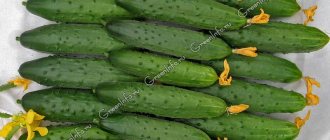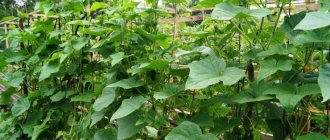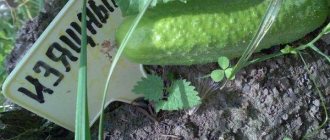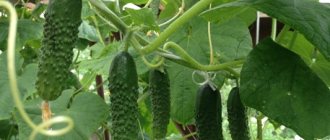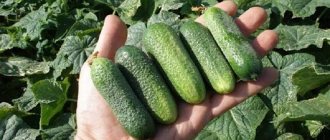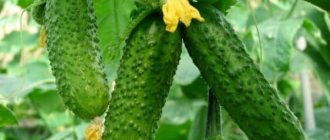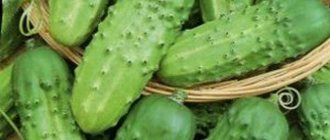Cucumber Buyan F1 is a bunched hybrid characterized by excellent taste, aroma and versatility of use. The fruits contain many vitamins and are indispensable for winter and summer salads.
| Landing location | Ripening time | Mode of application | Fruit length | Group | Fruit smoothness | Pollination method |
| Universal | Mid-early (46-55 days) | Universal | Medium - from 10 to 15 cm | Hybrid | Highly lumpy | Parthenocarpic |
History of variety selection
The Buyan F1 cucumber is a hybrid that was bred by workers of a breeding company called “Manul”. The company is located in Mytishchi, and the variety was opened in 1997. The authors of the developed variety are A.V. Borisov and O.N. Krylov.
A distinctive feature of Buyan F1 is its early ripening, so the cucumber ripens earlier than other varieties. Can be grown both in open ground and in greenhouse conditions. In 2000, the cucumber variety Buyan F1 was included in the state register of breeding achievements in 3 regions:
- Central;
- North-West;
- Volga-Vyatka.
How to properly grow and care for
Growing cucumbers requires certain knowledge. By adhering to generally accepted rules of care, you will provide your vegetable crop with a stable and high yield:
- Cucumber plants are moisture-loving, so it is very important to water them regularly (from 2 to 7 times a week, depending on the climate). The soil should not be allowed to dry out.
- Once a season you need to feed the bushes with complex fertilizer.
- Before planting seedlings in open ground, they must be hardened off. To do this, the plant is kept at a temperature of +16˚C for a week.
- When the soil temperature reaches +17, +18 ˚С, you can begin planting seedlings in the beds. Plant the plant and then water it thoroughly.
Caring for the plant consists of timely weeding to remove weeds, loosening the soil to allow oxygen to reach the root system and abundant watering with warm, settled water.
Description of the cucumber variety Buyan
The first thing that catches your eye when you see this variety of cucumbers is their bunchiness. One node can produce up to 7 cucumbers at once. At the same time, the plant is medium-sized and medium-climbing.
Buyan F1 indeterminate. This means that the central stem is not limited by the flower cluster during growth. The neighboring lateral branches are not massive, on the contrary, they are underdeveloped, so the entire load goes to the head stem, which holds a significant amount of fruit. In addition to genetic characteristics, the following factors influence the intensity of branching:
- planting in the shade;
- lack of moisture;
- low temperature;
- soil features.
Buyan's leaves are wide, medium in size, and have a rich green color. To the touch, there are both smooth and medium-wrinkled specimens. The edge of the heart-shaped leaf blade is wavy.
The description of the Buyan F1 cucumber is found in many botanical journals and indicates a female type of flowering. This means that such flowers are modified into an ovary or a small cucumber. This is precisely why they differ from male flowers. Male, or staminate, flowering occurs without ovaries.
The flower consists of 5 pointed star-shaped petals with a bright yellow color.
Description of fruits
Cucumbers of the Buyan F1 variety are produced in quantities of 6-7 pcs. on 1 node. They have a dense skin with uniform tubercles. There is no bitterness, the flesh is juicy and aromatic. The seed is whitish, watery and soft. Cucumber Buyan F1 weighs up to 100 g.
Important! The overgrowth of the gherkin is indicated by a length exceeding 12-14 cm, as well as a yellowish tint to the peel.
Externally, the fruits are oblong and cylindrical in shape. The color of the cucumber is dark green with a lighter shade at the ends. The average size of Buyan is 10-12 cm. You can see in detail what the Buyan cucumber variety looks like in the photo.
Features of agricultural technology of the variety, reviews
Cucumber Buyan can be planted as seedlings or directly into the ground. In the second case, work is planned when the air temperature reaches at least +17 °C. Seedlings need the same conditions for normal rooting. Place on 1 square. m of land 2-3 bushes (greenhouse) or 3-4 hardened plants (open bed).
Attention! Culture itself regulates branching. With a high fruit load on the main stem, side shoots stop actively appearing.
There are many reviews about this cucumber online. Lyudmila (Mari El) was pleased with the yield. The hybrid confirmed all the declared properties. Taganrozh resident Tuulos advises picking cucumbers on time. Otherwise, they outgrow and lose their taste appeal. Buyan and other gardeners speak in the same vein about the cucumber. The variety has interesting qualities and extensive cultivation practice in domestic gardens.
Characteristics of the variety
The most unpretentious are Buyan cucumbers, as is written in the description: they give an equally good harvest both in natural growing conditions and in greenhouses.
Comment! The first greenhouses are associated with the name of the ancient Roman emperor Tiberius, who loved cucumbers so much that he ordered to find a way to grow these fruits year-round.
Productivity and fruiting
The ripening of the Buyan F1 variety occurs on the 45th day after germination of the cucumber. This happens in the early period: late spring - early summer. Over many years of planting this variety of cucumbers, a trend has been noted: from 1 sq. km, you can harvest a crop weighing 9 kg; especially fertile soils can yield up to 15 kg of gherkins.
The yield of a variety depends on the following factors:
- planting seeds (a larger number of fruits will be obtained if the cucumber seeds were taken from the first or second ovary, and the “age” of the seeds is 2-3 years);
- treatment of seeds with biological preparations, which will subsequently protect the plant from temperature changes and diseases);
- depth of immersion of seeds into the soil;
- planting period and weather conditions;
- soil temperature;
- use of fertilizers;
- frequency and intensity of watering;
- tillage of soil against weeds;
- illumination of the planted area.
Application area
The variety is characterized by versatility of use. Cucumber Buyan F1 has established itself as a vegetable with excellent taste. It is grown both for independent consumption and for preparing various salads and canning. It is not demanding when it comes to salting and is preserved in the usual way. Cucumber Buyan F1 is widely used in livestock farming as a feed for cattle and poultry.
Resistance to diseases and pests
The cucumber variety Buyan F1 is highly resistant to many infectious and fungal diseases. In particular, he is not afraid of:
- brown spot;
- cucumber mosaic virus;
- powdery mildew;
- cladosporiosis.
The average resistance of the Buyan F1 variety to fungal diseases such as downy mildew is noted. The Buyan cucumber is resistant to pests, but in case of attack by aphids, mites, whiteflies and other parasites, the soil must be sterilized and treated with disinfectants and fertilizers.
Advantages and disadvantages of the variety
The main advantages of the Buyan cucumber variety:
- high productivity;
- resistance to infections;
- unpretentiousness;
- early maturation;
- excellent qualitative and quantitative indicators;
- possibility of planting in open and closed ground;
- relative resistance to changes in humidity and temperature.
Among the weaknesses, only one is named - poor immunity to peronospora.
Advantages and disadvantages
Pros:
- excellent taste;
- high commercial qualities - transportability, keeping quality;
- aesthetic appearance;
- universal use;
- self-pollinating;
- rapid ripening;
- high productivity;
- unpretentiousness to growing conditions;
- resistance to temperature changes;
- resistance to powdery mildew, cladosporiosis, cucumber mosaic and olive spot.
Minuses:
- vulnerability to peronosporosis (downy mildew).
Features of planting and care
Cucumber seeds are planted in the spring. Usually the manufacturer does the cleaning himself, but before immersing it in the soil, you can play it safe and dip the seed in potassium permanganate for 20 minutes, then soak it in warm water at room temperature for 5 hours.
Planting seedlings
Cucumber seedlings are stored in small paper or plastic cups (large containers are harmful due to acidification of the soil).
Attention! Buyan does not tolerate picking very well, so they use the transshipment method.
It is better to replant seeds in garden or turf soil with sawdust and humus. Before replanting, cucumber seeds are stored in damp cotton cloth; after 2-3 days, sprouts appear. When transplanting a sprout into open ground, experts advise placing the seeds in the refrigerator for a day.
Having gone through all the preparatory stages, the cucumber seeds are sent into a glass or pot to a depth of 1.5 cm (2 pieces per container). Then spray generously with water, cover with film and place in a warm room (21-24 oC).
How to grow cucumbers at home on the balcony is shown in the video:
Growing cucumbers using the seedless method
Buyan seeds are sown immediately after processing. Sowing is carried out on May 15-20. It is necessary to select the largest seeds and lower them into the soil to a depth of 2-4 cm. If planting is done in a hole, it is recommended to plant 4-5 grains. The distance between the beds should be at least 50 cm. If the soil is dry, before planting it should be moistened by adding a small amount of water to the hole. The optimal “age” of Buyan seedlings to obtain maximum yield is 2-3 years.
Transplanting cucumber seedlings of the Buyana variety into greenhouses occurs as follows:
- in autumn or spring, the greenhouse is disinfected with a solution of karbofos;
- the soil is treated with humus, peat or wood ash;
- the beds are fertilized with minerals;
- after treatment with minerals or organic matter, a hot mixture of mullein and bird droppings is poured into the soil;
- after all manipulations, cover the treated areas with film to retain heat, repeat the procedures for 5 days before planting the cucumbers;
- Wire is stretched over the beds so that the cucumber shoots can grow freely.
Aftercare for cucumbers
The Buyan cucumber variety is not picky, so caring for it is simple:
- in dry weather, cucumbers need daily watering; for temperate climates, 2 irrigations per week are sufficient;
- to protect cucumbers from the sun and wind, corn or other tall plants are planted on the paths between the beds;
- weeding Buyan F1 is appropriate only for thinned beds, since the root system of cucumbers is delicate, weeding must be done very carefully;
- every month cucumbers are fertilized with vitamins;
- The permissible temperature for transplanting seeds into open soil is 20 ° C, only planted cucumbers need to be well watered.
The secrets of the best feeding for cucumbers are collected in this video:
Bush formation
Pinching plays a role in the formation of a fertile bush. It is carried out when male barren flowers prevail over female fruitful shoots. But since the Buyan variety is a parthenocarpic hybrid, the cucumber does not need pinching.
Caring for Buyan cucumbers
Flowering and fruit formation in the Buyan F1 variety occurs at a temperature of +18–+25 °C. Low or high values disrupt the development of the ovary. Maintaining optimal indicators will ensure the correct formation of cucumber bushes.
For a bountiful harvest, it is recommended to mix several hybrids in one area. The parthenocarpic variety “Friendly Family F1” is planted next to the Buyan cucumbers.
Watering
Before buds begin to form, cucumber seedlings are watered at the rate of 4 liters of water per bush. At the fruiting stage of the Buyan variety, the consumption is increased to 8-10 liters per plant. Irrigation is carried out at least once every 3 days. When carrying out irrigation, air temperature is taken into account. Do not allow the soil to dry out.
Top dressing
Cucumbers respond by increasing yield to fertilizing. At the stage of active growth, seedlings are fed with urea or mullein infusion. 200-300 g of manure is dissolved in a bucket of water. In the fruiting phase, complex additives are used. Fertilize once every two weeks.
Garter and bush formation
Cucumber bushes are tied to supports. The top of the lash is tied with a loose loop of elastic thread at the level of the 3rd true leaf. The other end of the rope is attached to the upper support.
The cucumber vines are pinched. On the central stem below one and a half meters, side shoots are cut out. Flowers up to 5-6 true leaves are removed.
Loosening the soil and weeding
The variety does not really like weeding, especially if the plants are still small. The root system is very delicate, so weeding must be done very carefully so as not to harm the bushes. If the plants have grown too close or dense, you need to weed out weak and sluggish sprouts and thin out the beds. It is also necessary to weed the soil as the weeds grow.
Loosening must be carried out constantly, at least every two days, so that the soil does not dry out and the roots have enough oxygen to grow. If this is not done, bitterness may appear in the fruits.
Hilling
The procedure is combined with surface loosening of the soil. They destroy the dense earthen crust to enrich the roots with oxygen. Hilling promotes the growth of root mass and prevents the development of diseases.
Stepsoning
The modern variety “Buyan” does not require pinching. There is no need to pinch the shoots.
Possible problems
The variety is not considered problematic, as it is quite resistant to diseases and pests and does not require special care or maintenance. The only thing you should pay attention to is the soil. If you do not carry out the necessary preparation before planting, the plants will be lethargic, fruiting will be late and poor.
Problems with the appearance of downy mildew (withering, deformation of leaves, loss of fruits) are also possible. To avoid the appearance of such symptoms, it is necessary to spray and treat the soil with antifungal agents. Care recommendations include abundant watering and careful loosening of the soil.
In fact, caring for plants is quite simple; they adapt well to natural conditions and bear fruit well, especially if the necessary conditions are provided. Particular attention should be paid to the soil and place of growth. If you follow all the planting rules, regardless of the planting method, you will get a large amount of tasty and juicy fruits quite quickly.
Diseases and pests
Cucumbers are susceptible to various diseases, as well as pest attacks. Despite the fact that Buyan has a stable immunity to most diseases, every gardener needs to know their main signs, as well as methods of treatment and prevention:
- Powdery mildew is characterized by damage to the foliage of the plant, and in especially advanced cases, the stem, petioles and fruits. The main signs of the disease are the appearance of white spots on the outer part of the leaves. Over time, the disease covers the entire leaf, and subsequently spreads to the entire plant. The consequence of such a disease is the loss of entire vines and a decrease in the quality and quantity of the harvest. In the fight against powdery mildew, infected fragments are removed and burned, and the rest of the plant is sprayed with mullein or treated with ground sulfur powder at the rate of 30 g per 10 m². As preventive measures, it is recommended to clean the beds of weeds, use cold water for irrigation, avoid overwatering and follow the rules of crop rotation.
- Root rot. Rotting of the root system of cucumbers is caused by microorganisms. The pathogen lives in the soil and infects plant tissue. Entrances and young seedlings are most susceptible to infection. Description of the manifestations of the disease - withering of cucumber tops in wet soil, gradual drying of the vines, in the root zone the stem rots or dries out and cracks, the roots turn yellow. To prevent root rot, treat the soil and stems with biological fungicides. At the initial stage of the disease, the roots are sprinkled with sand and high hilling is carried out.
- Downy mildew or downy mildew - manifests itself in the form of yellow-green spots (with a light green coating) on the upper parts of the leaves, which later transform into a purple coating on the lower parts of the leaves. The disease is characterized by rapid spread to neighboring bushes and the ability to destroy entire fields of cucumbers. The fight against the disease consists of treating plants with a milk solution (1:9 and additionally adding 10 drops of iodine per 10 l) or urea solution (1 g per 10 l of water). As a preventive measure, it is necessary to use cold water for irrigation, carry out mandatory disinfection of seeds before sowing, and avoid increased soil moisture due to excessive watering.
- White rot - characterized by a coating of white mucus on all parts of the plant: foliage, stems, inflorescences and ovaries. To combat this disease, disinfection procedures are used for the soil or, in the case of greenhouse conditions, the entire greenhouse. To do this, 2 g of copper sulfate and 10 g of urea are diluted in a bucket of water, with the expectation that 1 liter of the drug will be required per 10 m². Prevention of the disease will be balancing humidity and avoiding planting density.
- Melon aphids are pests that destroy both leaves, ovaries, and fruits. Insect attacks lead to crop damage and leaf fall. At the same time, in cases of high humidity, the plant may die. To combat melon aphids, spray plants with an ash solution (200 g of ash, 50 g of planed soap dissolved in 10 liters of water) or an infusion of grass (1 kg of grass is soaked for a day in 10 liters of water). To prevent the attack of these pests, it is necessary to remove weeds and remnants of vegetation from the beds, adhere to the rules of crop rotation and carry out digging and disinfection of the soil.
- Spider mites are a pest that parasitize leaves, feeding on their greenery, which subsequently leads to the loss of entire beds. It is particularly dangerous in greenhouse growing conditions. A good remedy against spider mite attacks is considered to be treating crops with garlic or onion infusion (200 g of peel per 10 liters of water) or planting dill next to the beds. Preventive measures include avoiding drying out the soil in the beds, systematically cleaning and disinfecting the soil.
